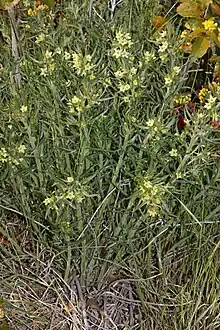Lithospermum ruderale
Lithospermum ruderale is a species of flowering plant in the borage family known by the common name western stoneseed or lemonweed. It is native to western Canada and the western United States, where it can be found in many types of habitat. A perennial herb growing from a taproot and woody caudex, it is covered with fine, more or less upright, hairs, especially on the stems. It produces a cluster of erect leafy stems ranging from 20 to 50 centimetres (7+7⁄8 to 19+5⁄8 in) centimeters in height. The stems support lance-shaped leaves ranging from 2.5–10 cm (1–4 in) in length.[1] Bunches of flowers with leaf-like bracts appear toward the top of the stem amongst the leaves. The corolla is fused at the base with five lobes[1] which are light yellow, often slightly greenish, and about a centimeter long and wide. The style is short. The fruit consists of one or two, sometimes four, clustered glossy grey nutlets, 3.5 to 6, sometimes as much as 8 mm long.
| Lithospermum ruderale | |
|---|---|
 | |
| Lithospermum ruderale in Wenas Wildlife Area, Washington | |
| Scientific classification | |
| Kingdom: | Plantae |
| Clade: | Tracheophytes |
| Clade: | Angiosperms |
| Clade: | Eudicots |
| Clade: | Asterids |
| Order: | Boraginales |
| Family: | Boraginaceae |
| Genus: | Lithospermum |
| Species: | L. ruderale |
| Binomial name | |
| Lithospermum ruderale | |
The plant was used as a contraceptive by several Native American groups, including the Navajo and Shoshone.[2] Studies on mice show the plant reduced their fertility.[3] Plains Indians also used the roots to treat respiratory issues and cooked them as food.[1]

References
- Taylor, Ronald J. (1994) [1992]. Sagebrush Country: A Wildflower Sanctuary (rev. ed.). Missoula, MT: Mountain Press Pub. Co. p. 24. ISBN 0-87842-280-3. OCLC 25708726.
- Ethnobotany
- MoBot Online Exhibit
External links
 Media related to Lithospermum ruderale at Wikimedia Commons
Media related to Lithospermum ruderale at Wikimedia Commons Data related to Lithospermum ruderale at Wikispecies
Data related to Lithospermum ruderale at Wikispecies- Jepson Manual Treatment
- "Lithospermum ruderale". Plants for a Future.
- Lithospermum ruderale in the CalPhotos photo database, University of California, Berkeley